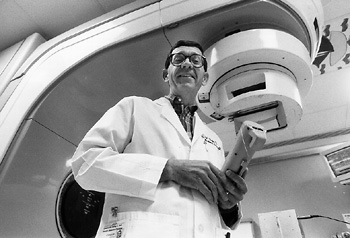
As chief therapy physicist in Radiation Oncology, Charles Coffey, Ph.D., determines how best to treat cancerous tumors while sparing surrounding tissue. (photo by Mary Donaldson)
Coffey takes aim at tumors using radiation 'prescriptions'
When someone asks Charles W. Coffey II, Ph.D., what he does for a living, he first gives his official job title: chief therapy physicist in radiation oncology.
Many times, though, when he senses that the person doesn't quite understand, he offers this unofficial job description: a pharmacist for filling radiation prescriptions.
"The physician decides on a course of treatment and relies on me to help deliver that radiation prescription," said Coffey, associate professor of Radiation Oncology and a member of the Vanderbilt-Ingram Cancer Center. "The medical physicist's role is to determine – using everything from simple logic to very complicated calculations – how best to treat the tumor and spare the normal tissue."
Under state and federal regulations, medical physicists play a key, behind-the-scenes role in any diagnostic procedure or treatment that involves radiation, whether it's conventional X-ray, CT imaging, or radiation therapy. They are responsible for both optimal diagnostics images and achieving the correct dose of radiation.
The field of medical physics developed in the early 1970s and has grown steadily as new technologies for using radiation in medical treatment and diagnostics have exploded. A national association representing professionals in this field today counts more than 4,500 members. Nearly a third of this group gathered in Nashville last month for the annual meeting of the American Association of Physicists in Medicine (AAPM).
At the meeting, Coffey was announced as the president-elect of the organization beginning Jan. 1, 2000. He will serve as president in 2001 and as chairman of the board in 2002.
"This was the first time for Nashville to host this meeting, which is designed for medical physicists to learn about the latest scientific and technological advances in the field," Coffey said.
Chair of the local organizing committee was Coffey's Vanderbilt colleague, Ronald Price, Ph.D., professor of Radiology and Radiological Sciences, who is Vanderbilt University Medical Center's chief diagnostic physicist.
It is an exciting time for medical physicists as new technologies come on the scene, Coffey said. Among the very latest advances discussed at the AAPM meeting were intravascular brachytherapy (use of radiation to augment coronary angioplasty and prevent recurrent blockage of the arteries) and intensity modulated radiotherapy (IMRT), a technique to tailor the dosage of radiation to the patient's specific anatomy.
VUMC has been a participant in clinical trials of intravascular brachytherapy, which is expected to be approved by the Food and Drug Administration for widespread use in the next 12-18 months, Coffey said. The Vanderbilt-Ingram Cancer Center will soon acquire the latest technology to begin delivering IMRT next spring. Renovation of the Radiation Oncology department in the basement of the Vanderbilt Clinic is under way to make room for the new equipment.
Traditionally, radiation beams have been shaped for therapy by blocking portions of the beam with lead blocks. With IMRT, the machine that shapes the beam uses narrow "fingers" that can be moved individually to shape the beam, and these fingers can be computer-adjusted in real-time throughout the procedure to deliver precise dosages to specific areas.
"With IMRT, we can change the total dose picture and really tailor it to the anatomy," Coffey said. "One hope of radiation oncology is to push the dose to the tumor higher, while making the procedure even safer for normal tissues."
Coffey is a member of the first real wave of medical physicists. He was drawn to the study of physics by a high school physics teacher, but by the time he was a junior in college, he realized an undergraduate degree in physics in the late 1960s-early 1970s offered limited employment opportunities.
On a whim, he and a friend at the University of Kentucky-Lexington took a course in medical physics during their senior year. It was 1971 and the first time such a course was offered at UK. Coffey was hooked.
He went on to get his master's degree at UK, followed by a Ph.D. at Purdue University. He then returned to UK, where he worked as a medical physicist and as a member of the faculty until joining the Radiation Oncology team at Vanderbilt six years ago.
Today, a portion of his duties include helping train the next generation of medical physicists. On his staff is a medical physics resident, who has a Ph.D. in physics and who is learning to be a clinical medical physicist. In addition, Coffey is involved along with Price and colleagues from Physics and Astronomy and Biomedical Engineering in teaching students in a medical physics graduate program. The first two students graduated from this two-year master's degree program in May, and the next class will begin its work later this month.













